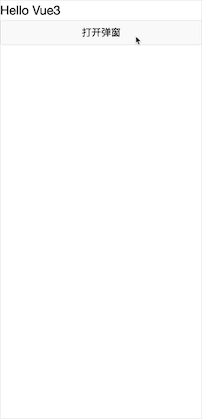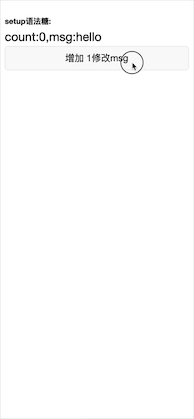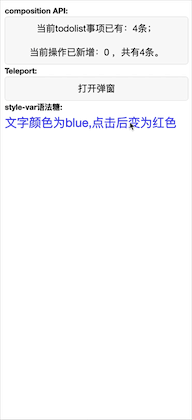前言
9 月 19 日凌晨,Vue3 在经过多个开发版本的迭代后,终于迎来了它的正式版本,”One Piece” 的代号也昭示了其开拓伟大航路的野心。
Vue3的新特性主要有 Composition API、Teleport、Fragments 和 <script setup /> & <style vars /> 等。我们是否也可以在小程序开发中使用这些特性呢?在 Taro 的文档里我们找到了关于 Vue3 的章节,事不宜迟,让我们开始尝试吧。
Vue3 部分新特性
还没了解过 Vue3 的同学也别急,先了解下Vue3的新特性吧:
1.Composition API
Vue2.X 基于 Option API(选项API)构建组件,一般来说组件拥有 data、methods、computed 等选项。这是一种属性相互隔离的模式,好处是各属性内容分离开,对于新手来说比较友好;但对于大型项目来说,为了修改某个功能,可能需要在一个文件中来回翻页。Vue3 增加了 Composition API 方式(组合 API ),基于 reactivity(响应式)的思想进行组件构建,将逻辑封装到函数中,可以实现类似ReactHooks 的逻辑组合和重用。对于大型项目,代码按照具体功能划分,而不是分散在不同的生命周期中,逻辑更加一目了然。

2.Teleport(传入)
Teleport功能,使得我们可以将全屏的组件(例如Toast)移到Vue APP节点外,而不需要在UI界面上修改其他组件样式,方便实现全屏蒙层、浮层弹窗等效果。
3.Fragments(碎片)
Vue2.x版本中,<template /> 标签下不支持放置多个组件,这个限制在Vue3中不再存在。这点比较好理解,下述组件设计在Vue3中是没有问题的:
1
2
3
4
5
6
|
<!-- Layout.vue -->
<template>
<header>...</header>
<main v-bind="$attrs">...</main>
<footer>...</footer>
</template>
|
4.实验性质的语法糖 <script setup>、<style vars>
a.<script setup>:用于在 SFC 中使用 Composition API 的语法糖,改善在单个文件组件中使用Composition API时的体验。
b.<style vars>: SFC 中状态驱动的 CSS 变量,它提供了直接的CSS配置和封装,支持将组件状态驱动的CSS变量注入到“单个文件组件”样式中。
除了以上 4 点之外,Vue3 还提供了自定义渲染,详细可以参考文末的推荐阅读文章。
如何在 Taro 里使用 Vue3
Vue3 带来的新特性可以让我们更加优雅和高效地进行开发,现在,来开启我们在 Taro 里使用 Vue3 的体验之旅吧。
Taro 已经默认安装 Taro3 ,所以正常安装即可:
1
2
3
4
5
6
|
# 使用 npm 安装 CLI
$ npm install -g @tarojs/cli
# OR 使用 yarn 安装 CLI
$ yarn global add @tarojs/cli
# OR 安装了 cnpm,使用 cnpm 安装 CLI
$ cnpm install -g @tarojs/cli
|
安装完成之后,使用taro --version查看一下是否安装成功,如果输出版本号说明安装成功。
安装成功后,初始化一个项目
将出现如下图的一些选型

如上图:
- 请输入项目名称?输入项目名称
vuedemo
- 请输入项目介绍?输入项目介绍
a demo project
- 请选择框架?当然是
Vue3啦
- 余下选项,如上面 3 个选项,根据自己的需要选择就好,不会有什么问题
一般情况下,依照提示选型好以后, Taro会自动安装依赖。如果由于网络问题导致安装不成功,就需要手动在项目路径下进行安装。
1
2
3
4
5
6
|
# 使用 yarn 安装依赖
$ yarn
# OR 使用 cnpm 安装依赖
$ cnpm install
# OR 使用 npm 安装依赖
$ npm install
|
安装后目录结构:

app默认代码如下,我们注意到,Taro3 在新建 Vue3 项目时已经修改了入口组件写法。
1
2
3
4
5
6
7
|
import { createApp } from 'vue'
import './app.scss'
const App = createApp({
onShow (options) {},
// 入口组件不需要实现 render 方法,即使实现了也会被 taro 所覆盖
})
export default App
|
page/index目录下index文件示例如下:
1
2
3
4
5
6
7
8
9
10
11
12
13
14
15
16
17
|
<template>
<view class="index">
<text>{{ msg }}</text>
</view>
</template>
<script>
import { ref } from 'vue'
import './index.scss'
export default {
setup () {
const msg = ref('Hello world')
return {
msg
}
}
}
</script>
|
编译运行微信小程序
编译后,打开微信开发者工具导入编译后的dist目录,首页内容和编译成 H5的表现都如下图:

验证Taro3对Vue3的支持度
Composition API
写个比较简单的 todolist 计数组件,假设目前已有 4 项代办事项,点击后将新增一项。这里会使用到Composition API 思路,以及 computed计算属性。
在用户点击时,第二行“当前操作新增”会根据点击次数递增,总计条数会在 4的基础上累加。
1
2
3
4
5
6
7
8
9
10
11
12
13
14
15
16
17
18
19
20
21
22
23
24
25
26
27
28
29
30
31
32
33
|
<template>
<button @tap="increment">
增加 1
</button>
<view>当前todolist事项已有:{{ existCount }}条;</view>
<view>当前操作已新增:{{ count }} ,共有{{ total }}条。</view>
</template>
<script>
import { ref, computed, onMounted, toRefs, watch } from 'vue'
export default {
name: 'case1',
setup(props) {
// ref响应式变量
const count = ref(0)
const existCount = ref(4)
// computed方法,在count的value发生改变时,会触发计算total
const total = computed(() => count.value + existCount.value )
function increment() {
count.value++
}
onMounted(() => console.log('component mounted!'))
return {
// 返回increment方法,existCount、count、total属性,供模板中调用
increment,
existCount,
count,
total,
}
}
}
</script>
|
页面表现如下所示,可见对于 Composition API 的支持的还是不错的。

Teleport
写个初次登录用户的欢迎弹窗。用户名从index.vue传入。首页代码如下:
1
2
3
4
5
6
|
<template>
<view class="index">
<Toast :user = username />
<view id="teleportToast"></view>
</view>
</template>
|
在 Toast.vue 中,我们会写个属性 to 为 teleportToast 的 Teleport 组件,代码如下:
1
2
3
4
5
6
7
8
9
10
11
12
13
14
15
16
17
18
19
20
21
22
23
24
25
26
27
28
29
30
31
32
33
34
35
36
37
38
39
40
41
42
43
44
45
46
47
48
49
50
51
52
53
54
55
|
<template>
<button @tap="showToast" class="btn">打开弹窗</button>
<!-- to和index.html中的view id一致 -->
<teleport to="#teleportToast">
<view v-if="toastFlag" class="toast__wrap" @tap="hideToast">
<view class="h2">弹窗标题:</view>
<view class="toast__wrap--msg">欢迎{{ user }},点击关闭</view>
</view>
</teleport>
</template>
<script>
import { ref,toRefs } from 'vue';
export default {
props:{
user: {type: String}
},
setup(props) {
// 获取用户名
const { user } = toRefs(props)
// Toast:显示flag
const toastFlag = ref(false)
let timer
const showToast = ()=>{
toastFlag.value = true
}
const hideToast = ()=>{
toastFlag.value = false
}
return {
user,
toastFlag,
showToast,
hideToast,
}
}
}
</script>
<style lang="scss">
.toast__wrap{
position: fixed;
width:100%;
height: 100%;
background: rgba(0,0,0,.8);
top: 0;
left: 0;
z-index: 101;
color: #fff;
.h2{
margin: 20px;
}
&--msg{
text-align: center;
}
}
</style>
|
在 H5 下是正常显示的,弹窗展示以及关闭功能效果如下;在小程序上却报错了,Taro 团队还需要加把劲:

Fragments
Fragments 特性已经在上面的例子中得到验证,使用没有问题。
script setup 语法糖
我们尝试一下<script setup>,组件里的代码如下:
1
2
3
4
5
6
7
8
9
10
11
12
13
14
15
16
17
18
19
20
21
22
|
<template>
<view>
<view>count:{{ count }},msg:{{ info }}</view>
<button @tap="incAndChangeInfo">
增加 1修改msg
</button>
</view>
</template>
<script setup=" props ">
import { ref, toRefs } from 'vue'
export default{
props: {
msg: String,
},
}
export const count = ref(0)
export const info = ref(props.msg)
export const incAndChangeInfo = () => {
count.value++
info.value = "change hello" + count.value
}
</script>
|
上述script标签里的代码效果等同于下面:
1
2
3
4
5
6
7
8
9
10
11
12
13
14
15
16
17
18
19
20
21
|
<script>
import { ref, toRefs } from 'vue'
export default {
props: {
msg: String,
},
setup(props) {
const count = ref(0)
const info = ref(props.msg)
const incAndChangeInfo = () => {
count.value++
info.value = "change hello" + count.value
}
return {
count,
info,
incAndChangeInfo,
}
}
}
</script>
|
调用它的代码传入 mgs 如下:
运行后,小程序和 H5 都是支持的,页面整体表现如下:

可以看到,运用新特性进行开发,代码书写更加便捷,逻辑更清晰。
style vars 语法糖
<style vars>,组件里的代码如下:
1
2
3
4
5
6
7
8
9
10
11
12
13
14
15
16
17
18
19
20
21
22
23
24
25
26
27
|
<template>
<view class="text">文字颜色为{{ color }},点击后变为红色</view>
</template>
<script>
import { ref,toRefs } from 'vue'
export default {
props:{
color: {type: String}
},
data(props) {
return {
color: ref(props) //'red'
}
},
setup(props){
const { color } = toRefs(props)
return {
color,
}
}
}
</script>
<style vars="{ color }">
.text {
color: var(--color);
}
</style>
|
调用它的页面里的代码如下:
1
2
3
4
5
6
7
8
9
10
11
12
13
14
15
16
17
18
19
20
21
22
23
24
|
<template>
<view class="index">
<Styledemo :color = color @tap="changeColor"/>
</view>
</template>
<script>
import { ref, computed, onMounted, toRefs, watch } from 'vue'
import Styledemo from "@/floors/styledemo"
export default {
components:{
Styledemo
},
setup () {
const color = ref('blue')
const changeColor = ()=>{
color.value = 'red'
}
return {
changeColor,
color
}
}
}
</script>
|
小程序和 H5 都没有问题,功能效果如下:

结语
我们将上述几个Demo 整合在一个项目中,放在Github上,有兴趣的同学可以看看。在线预览地址在这里。
经过验证,Taro3 支持使用最新的Vue3开发多端应用,相比之下H5的支持度更好一些。
值得一提的是,Taro 团队在技术上一直保持进取,在Taro2.0 版本支持了ReactHooks;根据Taro RFCS,早在2020-06-03也已经打算支持Vue3 了。截至目前,Taro 对 Vue3 的支持在小程序端的稍有补足,希望 Taro 团队可以早日补足这个短板。
推荐文章:
参考文章:
上次更新:2020-09-28 13:57:58
来源:oschina
链接:https://my.oschina.net/u/4319463/blog/4654652







